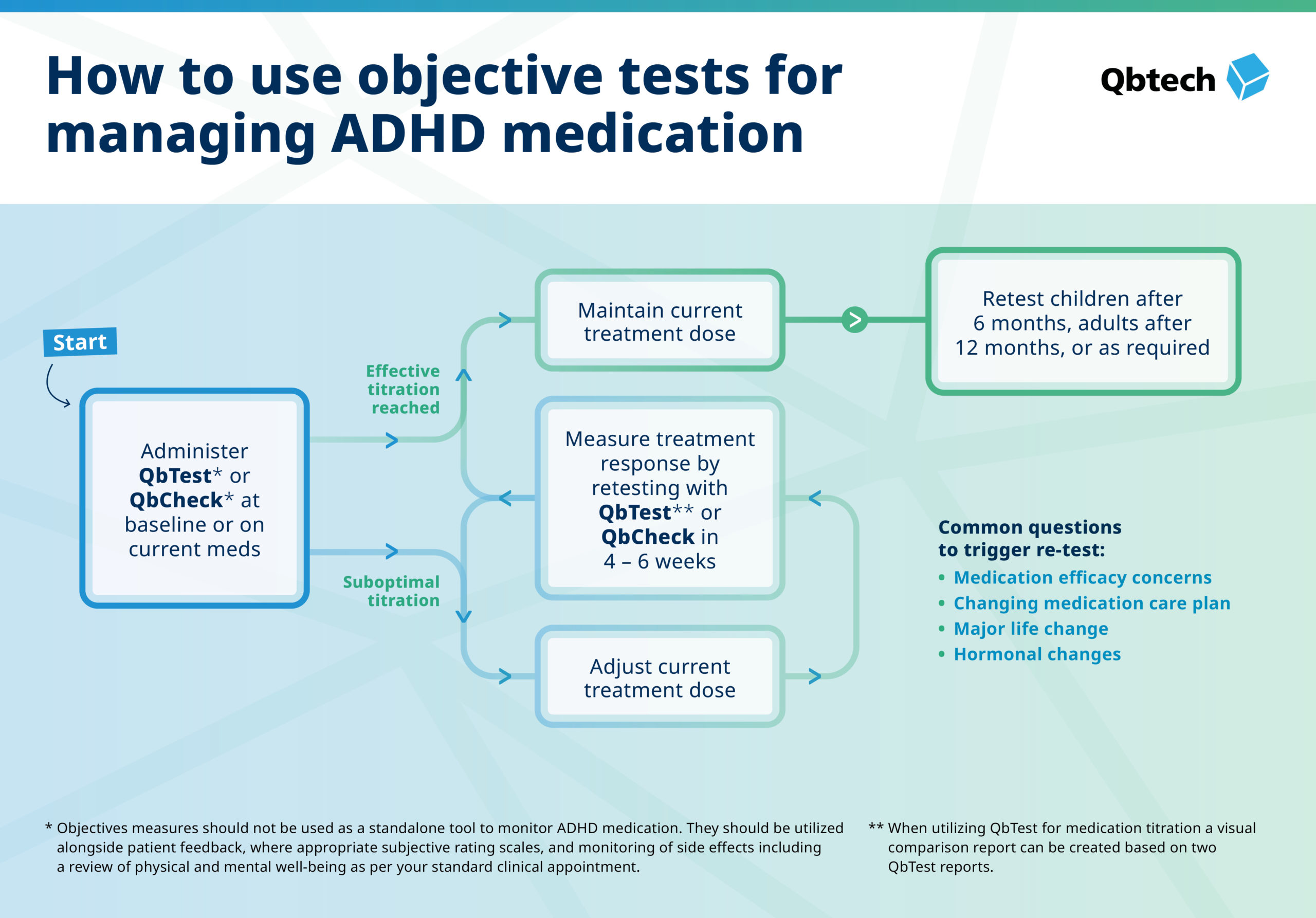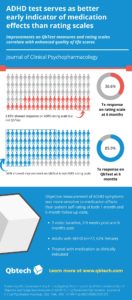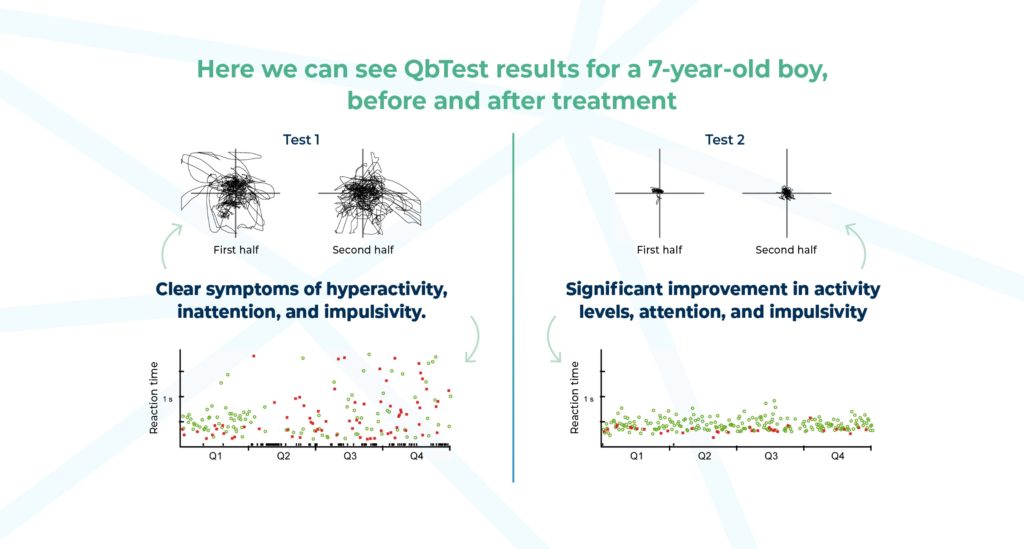Treatment review and medication management are incredibly important for you and your patients with ADHD. During clinic review appointments, treatment is usually assessed subjectively by discussing effectiveness and side effects with the person taking the medication, as well as family members, partners, or carers who have accompanied them to the appointment.
Using rating scales and subjective measures for ADHD evaluation
Rating scales are also used to determine if ADHD symptoms have reduced since starting treatment. At times, particularly in child and adolescent groups, rating scales are sent to schools or education providers to understand how the treatment plan works across different settings.
Difficulties with this approach may include:
- Rating scales are not generally validated for treatment monitoring and may not provide you with optimal information when trying to assess treatment effectiveness. They require routine repeats (often at three or six month intervals). The sensitivity of rating scales to pick up changes can be limited. There is also often a ceiling effect for changes of severe symptom levels.
- The patient taking the medication and/or those close to them may not always see improvement in symptoms. In fact, it has been suggested that it’s not until age 30 that individuals with ADHD are accurately able to estimate their level of impairment.
- For those who have been on medication long-term, it can be hard to provide a narrative of how one dose of medication feels in comparison to another.
- Rating scales are not always returned, or when they are, the information provided from another source like a teacher can differ from the experience of the patient taking the medication day-to -day.
- When there are co-occurring conditions, it can sometimes feel like nothing is improving because other symptoms are masking progress seen with medication.
Using objective testing for ADHD treatment management has more accuracy than other measures
The use of objective tests alongside subjective measures can give you additional insights into treatment effect – by providing data into how an ADHD medication care plan is impacting an individual’s core symptoms of hyperactivity, impulsivity, and inattention.
For example, in a study of ADHD treatment effects, Bijlenga et al. (2015) found that the objective ADHD test QbTest identified a clinical improvement in 57% of patients after treatment, compared to 40% when ADHD-RS was used (p=0.036).
Objective testing can be more sensitive to treatment effects than patient self-rating
Another study by Martin-Key et al., compared QbTest with ASRS for reviewing treatment effect. They found that it captured 86% of patients’ treatment effects, compared with only 37% of patients’ improvement on the ASRS rating scale. The study also noted that objective testing was more sensitive to medication effects than patient self-rating at both one-month and six-month follow-up visits.
These studies indicate the benefits of using objective testing for reviewing treatment effect compared to the main subjective ADHD rating scales for both children (ADHD RS) and adults (ASRS).
Starting treatment can be both an exciting and worrying time for those with ADHD. The nature of an objective test report allows individuals to see what impact medication is having throughout their treatment journey. Getting someone’s treatment right can help minimize side effects as well as help you to identify the lowest, most effective dose for the person they are treating.
Objective testing provides a patient-centered care approach
Objective testing provides you with a visual test and re-test report, which can be used to show how prevalent an individual’s ADHD symptoms are at baseline (before treatment) and then at optimized dosing. This can help to support a patient-centered approach by allowing them to make an informed choice with you around the next steps in their treatment plan.
These reports also capture symptoms that may not otherwise on a typical rating scale due to masking or camouflaging strategies. With an objective test report comparing the individual to themselves over time, it can create a bespoke depiction of their ADHD treatment management rather than tick boxes against DSM-5 criteria which are broad.
The following report extract illustrates this. Test 1 (left) is a baseline result before medication and test 2 (right) after starting treatment.
Objective testing allows clinicians to be agile in response to wider issues such as medication shortages
As a clinician, you’ll be familiar with the global medication supply issues which have impacted aspects of clinical care and medication access more recently. Objective measures can be used to check treatment effectiveness and optimization in the situation that a change in brand is required due to stock and supply chain breakdown.
Changing medication can be an understandable source of concern for the community who are prescribed ADHD medication, and therefore objective measures can provide peace of mind and a visual approach to re-titrating. More importantly, it can enhance the voice of the patient if treatment is leading to de-stabilization, allowing you to act quickly and effectively to adapt their treatment plan.
When conducting a re-test, you can include details such as brand and dosage of medication, and how long since it was taken. This allows for detailed comparisons between tests of treatment effect, including identifying at what point in the release profile of medication a test is administered.
Medication profiles and variance
Treatments for ADHD are very time-sensitive. Stimulant medications can start working on the same day as first taken, whereas non-stimulants may take 2-6 weeks to take effect. Release profiles also vary between medications.
QbTest reports are time and date stamped. The test can therefore be used to closely track treatment impact at different times of the day or month. This can help you to finetune dosages or try medications with different release profiles if medications wear off too quickly or are ineffective. This may be additionally important for women who can experience changes in treatment effectiveness linked to hormone fluctuations.
How to manage treatment with QbTest and QbCheck
The following flowchart illustrates how objective testing can be used within your pathway to manage treatment effects

Disclaimer: This is a quick reference guide and is in no way a substitute for clinical training. The purpose of this document is to give clinicians a bird’s eye view of what to expect when interpreting an objective test, e.g. QbTest and QbCheck.


